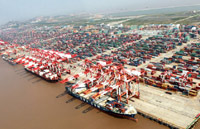Moves to reshore signal a gradual return to 'Made in US'
By Paul Welitzkin (China Daily) Updated: 2015-02-04 07:27Ferrise said many factors must be considered when outsourcing to China or any country, such as the cost of qualifying a supplier in China or a delay in shipping.
But even Ferrise has not broken all his ties with China. "We get components from Mexico and China. We will make a blend to reach our primary threshold," he said.
Another factor limiting reshoring is that many suppliers in a manufacturing supply chain also have relocated to China.
"Once US companies decided to move production to China, about two to four years later their suppliers also moved to China. We find that companies are coming back to the US, but many of their suppliers are staying in China. They are being cautious," said Patrick Van den Bossche, a Kearney partner and one of the authors of the reshoring report.
"Ten years ago, it was a slam-dunk case on whether it's cheaper and more productive to manufacture in China over the US. That is not the case anymore," said Moser.
According to Sirkin, if transportation costs are high, US companies are more likely to reshore. But if US labor costs are high, a company is less likely to bring manufacturing back.
The ideal conditions for reshoring are high transportation costs abroad and low US labor costs, he said.
The US has regained its manufacturing competitiveness because companies have managed to address most of their major costs.
"Manufacturers in the US have done a good job in maintaining costs and increasing productivity. This has helped large contract manufacturers to look at and in many cases choose a US location," said Sirkin.
"Shipping products from China is time-consuming and costly. Chinese wages are rising and the Chinese currency is appreciating and energy prices such as electricity and natural gas are lower in the US. It's estimated that about 25 percent of what the US imports from China to be sold in the US, would actually be more profitable if it were made here," said Moser.
While labor costs have stabilized in the US, they have risen sharply in China. Van den Bossche said the labor cost advantage still exists in China, but the gap continues to shrink as labor costs will continue to increase on the Chinese mainland. In the Yangtze River Delta region, he said labor costs averaged 82 cents an hour in 2001. In 2014, the figure was $4.93.
- Top 10 rich Chinese on Hurun List 2015
- Capital account shifts into the red
- Technology giants in flap over gift envelopes
- Drones taking to the air in test for delivery services
- Officials vow to plug tax loopholes
- China has great potential in engineering: former BP chief
- Hixih, Continental launch Yanzhou JV
- Chongqing unveils huge shale investment
















